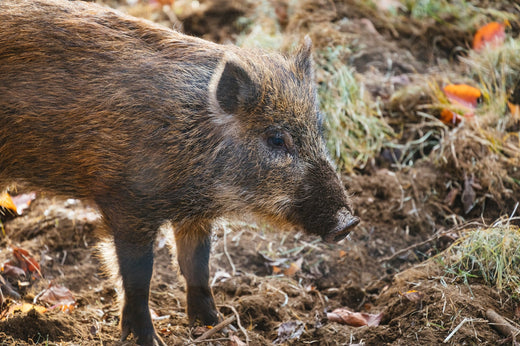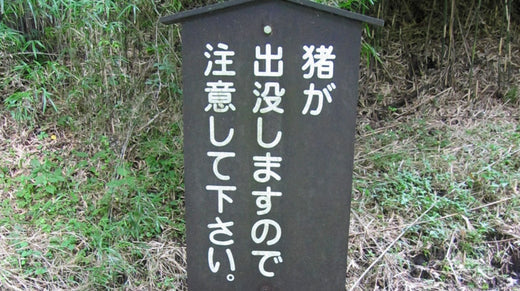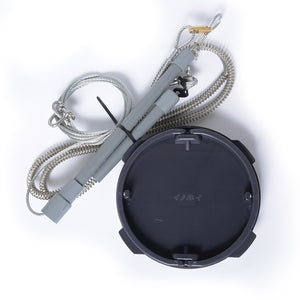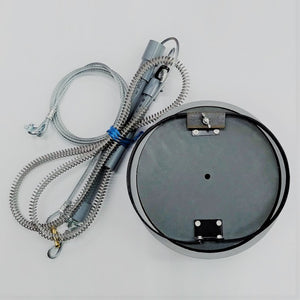The relationship between Japanese people and wild boars is older than rice farming, and as farming spread, the damage caused by wild boars also increased. As seen in boar fences, Japanese people have long been plagued by wild boar damage, but in recent years, there have been cases where the situation has become so serious that agriculture cannot continue.
Especially in mountainous and foothills, wild boars cause serious damage to crops, and it is becoming a big problem. Then, should the wild boar be eradicated as a countermeasure? The answer is "No". It is not a measure that should be selected from various viewpoints such as the impact on the ecosystem.
However, it is difficult to reduce the damage only by passive control. In order to effectively prevent damage to agriculture and forests by wild boars, it is necessary to understand the ecology and behavior of wild boars in detail, and to devise comprehensive measures for their coexistence and symbiosis.
In this article, we will explain the ecology and behavior of wild boars in detail so that we do not implement meaningless measures due to misunderstandings about the ecology and behavior of wild boars.
Wild boar ecology
Types and habitats of wild boars in Japan
The wild boar that inhabits Japan is divided into two subspecies: the Japanese wild boar, which is widely distributed in Honshu, Shikoku, and Kyushu, and the Ryukyu wild boar, which is distributed in areas south of Amami Oshima and Okinawa. Ino-buta, a crossbreed of pigs and wild boars, inhabits all over Japan.It inhabits evergreen broad-leaved forests, deciduous broad-leaved forests, abandoned paddy fields, bamboo forests, etc. In many cases, it infests paddy fields and farmlands adjacent to these and destroys crops. They may also appear in urban areas. They prefer areas with food and water, bushes and other hiding places, and areas with little human activity.
Its distribution has been expanding year by year, and in the 36 years from 1978 to 2014, the wild boar's habitat expanded about 1.7 times.

Above: Wild boar distribution and forecast expansion (Excerpt from the Ministry of the Environment website )
Since wild boars do not hibernate, their distribution in cold regions is small, but the northern limit of their distribution tends to expand year by year due to global warming.food
Wild boars are omnivorous and will basically eat anything, but most of them will eat plant matter. They like to eat beech fruits such as acorns, chestnuts, mushrooms, and soft shoots and roots of plants.
They also dig and eat underground potatoes, bamboo shoots, and bracken. In addition, sweet potatoes are sometimes dug up, covered with kaya and stored. Agricultural crops most affected are rice, sweet potatoes, beans, and sugar cane. There have also been reports of rice plants being wiped out overnight.
They also eat snakes, frogs, insects, freshwater crabs, and earthworms. There are also cases of land being destroyed by wild boars eating earthworms in fields and lawns. Wild boars that appear in urban areas also eat raw garbage.
Crops and plants that have not been damaged for several years may suddenly begin to eat, so be careful.physical ability
body size and structure
An adult Japanese wild boar weighs between 60kg and 100kg, but the Ryukyu wild boar is smaller, weighing around 60kg even at its largest.
The length of the Japanese wild boar is around 140-170 cm, but the length of the Ryukyu wild boar is around 90-140 cm. In both cases, males are larger than females. It is covered with thick fur, and even if it hits its body with hard thorns, it does not feel much pain.
The body shape is similar to pigs, but the front body is more developed than pigs. Both males and females have well-developed canine teeth on the lower jaw, but males are particularly well-developed.
They also have an excellent sense of smell, which is said to be comparable to that of dogs. On the other hand, it has weak eyesight, which is less than 0.1 in humans, and seems to rely on its sense of smell and hearing to detect enemies and prey.
running speed and jumping ability
It is said that it is possible to run at a speed of 45km per hour. They are so fast that even hounds cannot keep up with them. The image that you can only go straight, as in the word reckless rush, is a mistake.It has a high jumping power, and even a young boar under the age of one can jump about 70 cm, and an adult boar jumps over 1 m without running up. There have also been reports of jumping over 1.2m fences. When installing a protective fence, it is important to install a height that will not be jumped over.
In addition, they have a habit of preferring to crawl through rather than fly, and even adults can crawl through narrow gaps as long as they are 20cm tall.
strength of power
It has the power to lift a 70kg object with its nose. It also has a strong rushing power, and its attacks are said to be many times faster than those of humans of the same weight. Even an adult human being is in danger of being bounced and seriously injured.
The biting force is also very strong, and there have been accidents where the fingers have been bitten off. In the case of males, they may attack by sobbing up the tip of their nose with a strong force. Since the position of the tusk is exactly at the height of an adult's thigh, there have been accidents where the femoral artery was cut by a boar and died due to blood loss.
growth and lifespan
The wild boar breeding season begins in December-January and lasts about three months. During the breeding season, the male emits a peculiar odor during the mating season, loses weight and loses appetite, and actively wanders around in search of females (the meat of males during this period has a strong odor).
The estrus period for females lasts for three days, and after mating is completed during that time, the males search for another female in estrus to mate with. Females are prolific and give birth to 2-8 young in the spring. Some females that fail to give birth in the spring go into heat and give birth in the fall. The gestation period is about 120 days.
Ino pigs can breed all year round, and are said to have five times the fertility of wild boars. Juveniles have stripes and are called uribou. This striped pattern disappears about 4 months after birth after the lactation period.
They grow quickly and reach sexual maturity at the age of one and a half years. Males leave the herd after about a year and start living alone. Females, on the other hand, form family groups with their offspring.
The range of movement is within a radius of several hundred meters in the vicinity of Satoyama, but it may extend to about 3 to 5 km. They do not have specific territories, and multiple flocks may use the same area. There are feeding grounds, sleeping areas, watering areas, and a nuta-uchi* area within the living area.
*Nuta uchi is an action to remove parasites such as mites attached to the body and regulate body temperature, similar to bathing and bathing in humans.
The natural mortality rate in the first three years of life is high, and the average life expectancy is about two to three years. In areas where hunting pressure is high, the mortality rate of adult animals is high, and nearly half die each year from hunting, resulting in an average life span of less than two years. However, if the conditions are favorable, it is said that it is possible to live for about 10 years.
Personality and behavior of wild boars
personality
It is a very nervous and cautious animal. When encountering something unfamiliar, it tries to avoid it as much as possible, so it basically avoids humans. However, they may attack if you approach them carelessly.
They are especially aggressive during estrus and after parturition. Behaviors such as ruffled fur on the back, moving around suspiciously, making "whooshing", "cack-cuck", and "chuck-chuck-chuck" sounds, and scraping the ground while backing up are threatening behaviors of wild boars.
It also has the characteristic of becoming bold when it gets used to people, and there are cases where wild boars that are accustomed to people attack people, aiming at shopping bags.
*If a wild boar is approaching, do not panic and keep your eyes on it, and slowly back away. Sudden movements can startle wild boars and cause them to behave unexpectedly.
If you are approaching a supermarket bag or food, keep the food or bag away from your body. Avoid excite the boar by chasing it carelessly.
action
Wild boars are generally considered nocturnal animals, but they are actually diurnal. They tend to be more active at night because they avoid times when humans are active. Due to their strong vigilance, they frequently change their feeding grounds, beds, and watering areas, and act to prevent their behavior from being caught as much as possible.
However, when their vigilance against humans is lowered, they will be active even in the daytime. In many cases, the route to enter a human village is unified, and there is a tendency to use the same route when leaving a human village.
They often use their nose, which has an excellent sense of smell, to explore the feel of things. They have a habit of carefully examining gaps, depressions, and boundaries with their noses. The height of the nose of an adult Japanese boar is about 40 cm, and that of a juvenile (Uribo) is about 20 cm. By the way, when installing an electric fence, you can expect a high protective effect by passing the fence wire around the nose.
It has a high learning ability and can easily break through a weak wire mesh. It is said that they remember what they have learned once for more than half a year, and if they recognize it as a "feeding ground", they will persistently invade it again and again.
They also imitate other wild boars that have successfully invaded. They quickly become accustomed to light, sound, and smell control once they know there is no danger.Damage countermeasures considering ecology and behavior
Wild boars have a high fertility, so it is necessary to not only prevent damage but also exterminate them. Their home range is surprisingly narrow, so if damage is concentrated in a specific area, it can be assumed that wild boars have settled nearby.
It is important to know the habitat and exterminate the resident individuals. In addition, it is better to think that repellent materials based on odors and tastes have only a temporary effect. Even if you think that the avoidance behavior is confirmed by the avoidance material, in fact it is just avoiding things that are different from usual due to timid nature, and most of the patterns are completely ineffective once you get used to it.
If wild boars are essentially repelled, it is important to create an environment that prevents wild boars from settling near humans. To do so, you can take the following measures.
If the damage is left unattended, the wild boar will grow bolder and the damage area may expand. It is important to work on the above measures throughout the region, and to continue these efforts.
▶We also handle equipment used for mowing bushes.

 箱罠
箱罠
 くくり罠
くくり罠
 パーツ類
パーツ類
 電気柵
電気柵
 自作キット
自作キット
 防獣グッズ
防獣グッズ
 監視カメラ
監視カメラ









![Fare Asahi Shiki Box Trap Big Size [Double Door]](http://inohoi.jp/cdn/shop/products/20180504_5c53af_300x300_crop_center.progressive.jpg?v=1597991101)
![Fare Asahi Shiki Box Trap Big Size [Single Door]](http://inohoi.jp/cdn/shop/products/20180506_c693cd_e969a0f5-abac-49ee-8f2b-6de0f385e3fd_300x300_crop_center.progressive.jpg?v=1597991123)
![Fare Asahishiki box trap medium size [single door] wire mesh specification](http://inohoi.jp/cdn/shop/files/main_300x300_crop_center.progressive.png.jpg?v=1720764665)
![Fare Asahi Shiki Box Trap Medium Size [Single Door] Deep Type](http://inohoi.jp/cdn/shop/files/f9d83dbb4ed93f76265b8cd23c07b474_300x300_crop_center.progressive.jpg?v=1726117508)
 box trap
box trap
 tying trap
tying trap
 enclosure trap
enclosure trap
 Prevention and avoidance goods
Prevention and avoidance goods
 electric fence
electric fence
 trap surveillance camera
trap surveillance camera
 transportation goods
transportation goods
 Trap detection sensor
Trap detection sensor
 hunting supplies
hunting supplies
 hunting books
hunting books
 Anti-bird goods
Anti-bird goods
 Agricultural materials/machinery
Agricultural materials/machinery
 boar
boar
 deer
deer
 Kyon
Kyon
 monkey
monkey
 raccoon
raccoon
 Badger
Badger
 palm civet
palm civet
 raccoon dog
raccoon dog
 nutria
nutria
 mouse or rat
mouse or rat
 Mole
Mole
 bear
bear
 pigeon
pigeon
 Crow
Crow







